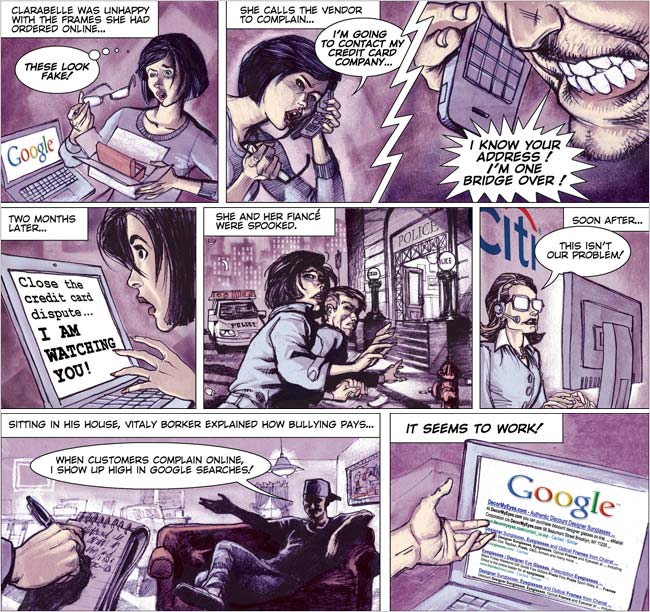« Digital Life: A Cautionary Tale »
 New York Times reporter David Segal published a terrific investigative piece at the end of last year (11/26/2010). In case you missed it, I recommend reading A Bully Finds a Pulpit on the Web. It's about the owner of a web-based business that provides eyeglasses, contact lenses and eyeglass repairs. This owner verbally abuses and threatens customers because he knows they will post complaints on the web. Each time they do, he says, his position in Google search results improves. Of course, in today's digital marketplace, the higher up your company appears in Google searches, the better your sales potential. It was a vicious attempt "to game" the social media aspect of online marketing and eCommerce.
New York Times reporter David Segal published a terrific investigative piece at the end of last year (11/26/2010). In case you missed it, I recommend reading A Bully Finds a Pulpit on the Web. It's about the owner of a web-based business that provides eyeglasses, contact lenses and eyeglass repairs. This owner verbally abuses and threatens customers because he knows they will post complaints on the web. Each time they do, he says, his position in Google search results improves. Of course, in today's digital marketplace, the higher up your company appears in Google searches, the better your sales potential. It was a vicious attempt "to game" the social media aspect of online marketing and eCommerce.
The Story At-A-Glance
Below is the compelling editorial graphic story that accompanied the Davis Segal article. It gives you the gist of what happened to this woman and other victims of the aggressive online business owner.
 Image via New York Times. 11/26/2010. David G. Klein.
Image via New York Times. 11/26/2010. David G. Klein.
Read This Article for Two Big Reasons
- It proves the digital marketplace remains a "wild west" of commerce. This business owner was scamming people, spewing verbal abuse and threatening unsatisfied customers for years, yet he was not shut down by any of his digital enablers. This included: 1) the credit card companies that often proved unhelpful to consumers, while helpful to the unscrupulous business owner; 2) Google, which placed the business owner's page ranking at the top of searches with no warning to consumers; and 3) the police and other law enforcement agencies who claimed they did not have enough evidence to convict. Because of this lack of response, the rogue business owner was left to pursue his twisted ways.
- It proves you cannot trust any website, no matter how "valid" it looks. Consumers must research unknown entities before making online purchases. ResellerRatings.com is a fast and simple website that provides the basic information needed by consumers to start a meaningful background search. If any of the victims featured in the New York Times piece had taken the time to visit ResellerRatings.com first, I guarantee none of them would have completed an online transaction with the fraudulent company. The real-life complaints are horrifying -- and there are so many of them!
Two More Reasons To Read This Article
- It proves long-form investigative journalism is alive and well. This lengthy article (5,681 words) prompted well over 300 comments within a day of its publication. A surprising number of those comments included words of thanks to New York Times editors and publishers, reporter David Segal and researcher Toby Lyles for the "unusually" in-depth reporting. One person described the piece as "good old investigative journalism on a very modern subject." Others gave words of encouragement to keep this type of article coming. People, it seems, are not afraid of long copy. They will read and they will learn if the writing is good and the message compelling.
- It proves that online newspapers have a growing value in our culture. Can anyone remember the days when reader feedback was limited only to the few selected "Letters to the Editor?" Those days, thankfully, are long gone. They have been replaced with a newer, more social form of reader feedback that allows readers to comment, complain or congratulate publications and reporters with an unprecedented immediacy. Comments, for the most part, add a significant new dimension to published articles. It is fascinating to read through them and I often find myself digging further into a subject based on comments and links provided by other readers. It takes the news reading experience to a new participatory level that greatly enhances the overall experience.


 Trish Fischer
Trish Fischer